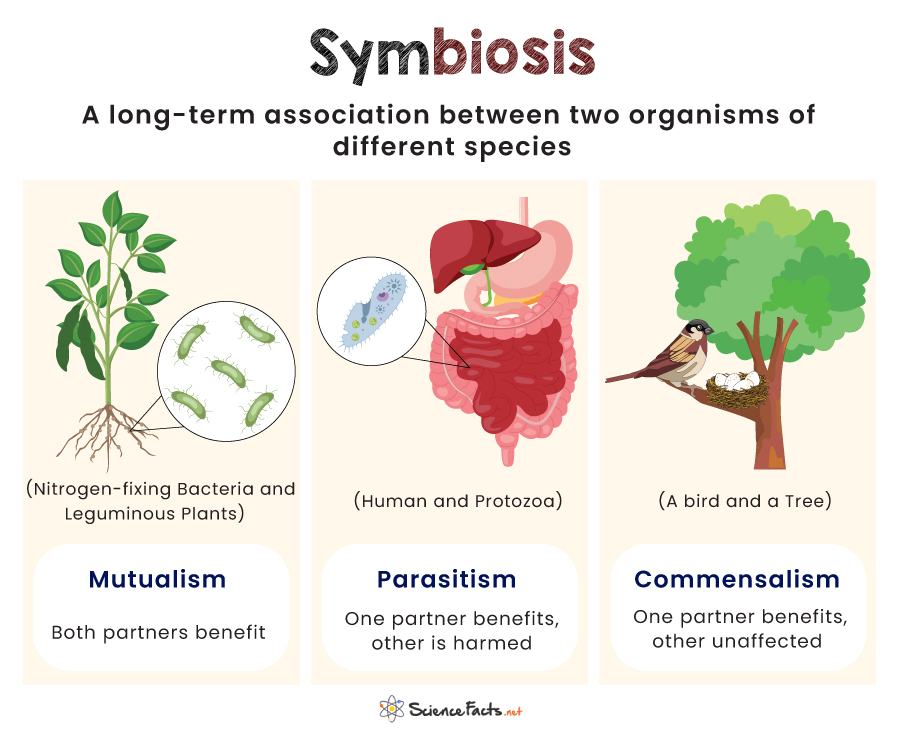Symbiosis describes any long-term relationship or interaction between two organisms of different species. It is a long-term biological association where at least one or both organisms benefit. The organisms involved in symbiosis are called symbionts. Symbiosis can be obligate or facultative. In obligate symbiosis, both organisms cannot survive without the other. They are interdependent. In facultative symbiosis, the organisms are involved by choice and can survive without the other. All symbiosis can be either endosymbiosis or ectosymbiosis. In endosymbiosis, one of the symbiotic partners lives within the body of the other. Endosymbiosis can occur within the cells (intracellular) or outside (extracellular). In contrast, in ectosymbiosis, one of the partners lives on the host’s body surface, such as the digestive tract, or glands, such as mucus and sweat.
Types of Symbiosis
Symbiosis vs. Mutualism
Despite the above classifications, symbiosis is broadly classified into three types: mutualism, parasitism, and commensalism.
1. Mutualism
Mutualism is a form of symbiotic association where both partners benefit from each other. It is also called mutualistic symbiosis.
Examples
Nitrogen-fixing Bacteria and Leguminous Plants: In this association, the bacteria live within the roots of plants such as peas, beans, clover, alfalfa, and soybean, where they convert atmospheric nitrogen into nitrates, a form that the plants can use. Similarly, the plants allow the bacteria to live and use carbohydrates produced by the plants through photosynthesis. Fungi and Plants (Mycorrhizas): The fungi colonize the plant roots within or outside the cell. The fungi utilize the food produced by the plant, while the fungus supplies the plant with minerals like phosphorous required for plant growth. Clownfish and Sea Anemone: Sea anemones found attached to the surface of the coral reefs trap their prey with stinging cells called nematocysts located on their tentacles. Nematocysts release toxins in response to a small animal attaching to its tentacle. It paralyzes the animal allowing the anemone to bring its food close to its mouth for ingestion. However, clownfish secrete a substance in their mucus that prevents the firing of toxins by the nematocysts. Thus, the clownfish quickly swim between the tentacles of anemones in an environment secure from its potential predators. In this way, clownfish benefit from their relationship with sea anemones. The anemone also gains as the bright-colored clownfish attracts other fishes looking for their food, which the anemone eats. Mesquite and Cacti: The cacti provide shelter and shade for the mesquite, whereas the mesquite provides nitrogen-rich leaves as nutrients to the cacti that fall to the ground and decompose. Thus, this symbiotic relationship helps both plants to survive in the harsh environment. Crabs and Sea Urchins: The sea urchin gets food from the crab, while the crab protects the sea urchin, as other animals find crabs scary.
2. Parasitism
Parasitism is a symbiotic association where one partner (the parasite) benefits while the other partner (the host) is harmed. Some parasites live on the surface of the host, while others live inside them.
Examples
Human and Protozoa Entamoeba histolytica (Amebiasis): The parasitic protozoa Entamoeba histolytica typically found in the colon can sometimes become invasive and cause intestinal disorders like diarrhea or dysentery causing death to children below five years. Animals and Tapeworms: Tapeworms are flatworms found attached to the inner sides of intestines in animals such as cows and pigs. They derive their food from the host, while the host animals suffer from diseases caused by them.
3. Commensalism
Commensalism is a symbiosis where one partner benefits while the other remains unaffected. Thus, the benefited partner uses the other for food and different needs.
Examples
Bird and Tree: A bird makes a nest in a tree, while the tree gives shelter and protection to the bird without getting harmed by the bird. Cattle Egrets and Insects: Cattle egrets eat the insects stirred up by cattle when they are grazing. The cattle are unaffected, while the birds gain food.
